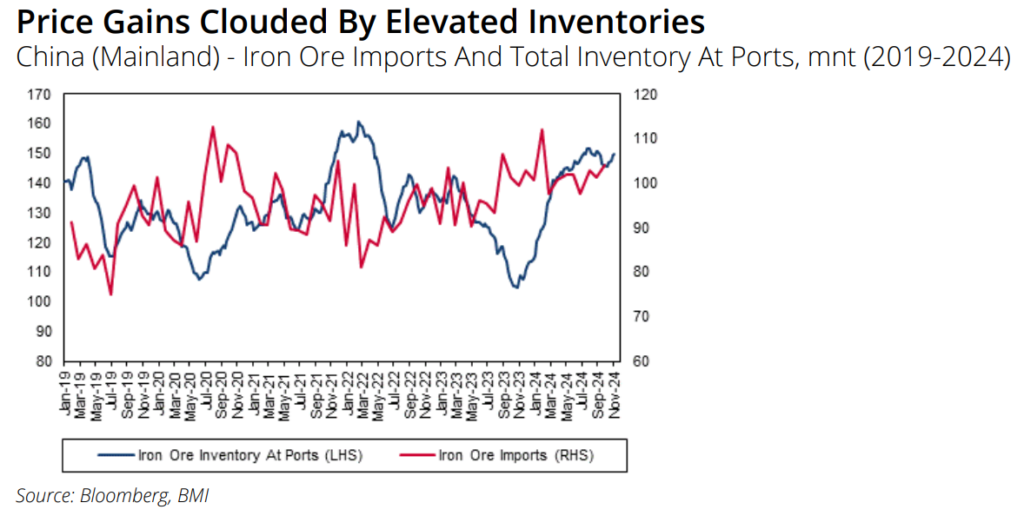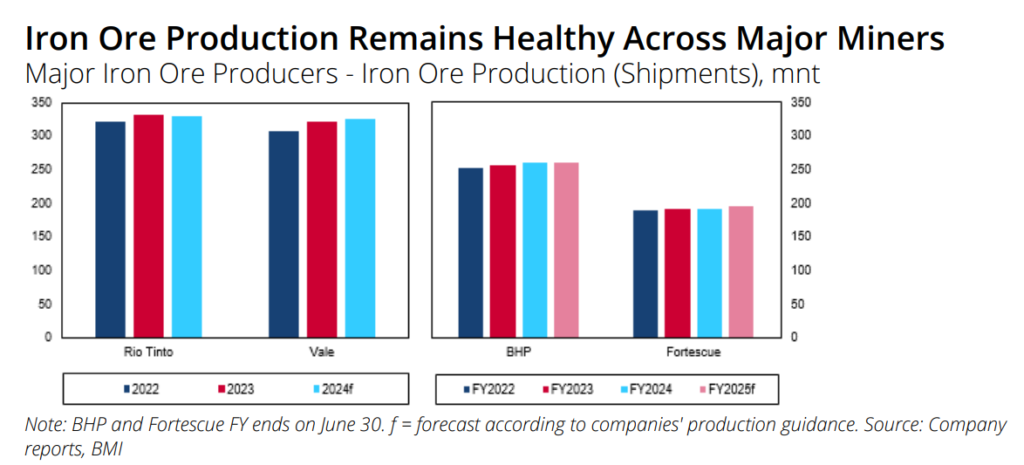Iron ore weakness to continue into 2025 and beyond, says Fitch Solutions’ BMI
“Iron ore prices are likely to remain highly sensitive to potential stimulus announcements, with market sentiment skewed towards expectations of further support in light of anticipated rekindled trade tensions under a second Trump presidency,” the report notes.
“The extent of any provided stimulus will be crucial in determining whether it can turn the tide for the iron ore market,” it adds.
Demand subdued
On the demand side, BMI’s report points out that steel production in China, and thus demand for iron ore, still remains sluggish, with property sector weakness adding to the grim picture.
According to the World Steel Association, during the first nine months of 2024, China’s production of crude steel declined by 3.6% year-on-year, with production in September falling by 6.1%.
While China’s manufacturing PMI surprised to the upside, returning to an expansionary territory for the first time in six months, registering a reading of 50.1 in October compared to 49.8 in September, BMI says the “ongoing property downturn still shows little sign of reversing.”
During the first nine months of 2024, investment in the real estate sector declined by 10.1% y-o-y, after falling by 10.2% over January-August 2024, while new construction floor starts contracted by 22.2%, BMI data shows.
“The recently unveiled raft of stimulus measures presents an upside, however, our country risk team highlights that addressing the property market downturn will be a multiyear effort, given the scale of unfinished projects and unsold housing stock,” BMI notes.
Elevated inventories
While China’s imports of iron ore remain elevated, rising by 4.9% y-o-y over January-October 2024, with demand turnaround expectations and a lower price environment acting as a tailwind, BMI says they were likely adding largely to stocks.
Data shows a strong build-up of iron ore inventories at Chinese ports, rising by 31% year to date to 149.9 million tonnes (mt) as of Nov. 8, which has the potential to place a cap on prices in the coming months.

Outside of China, steel production and demand for iron ore remain muted so far. According to the World Steel Association’s report, global crude steel production declined by 1.9% y-o-y over January-September 2024, with September registering a sharp decrease of 4.7%.
Supply healthy
On the supply side, iron ore production remains healthy across major miners, BMI notes. Iron ore shipments and production broadly increased for most majors, with miners aiming to maintain their production levels.

BHP saw record iron ore production in FY2024 (year ended June 30) of 260mt, a 1% y-o-y increase, and FY2025 production to come in at 255-265.5mt.
Fortescue maintained its iron ore shipments guidance for FY2025 at 190-200mt, slightly up from 191.6mt reached in FY2024.
Vale’s iron ore production guidance for 2024 has been recently revised upwards to 323-330mt from the previously expected 310-320mt.
Lastly, Rio Tinto’s 2023 iron ore shipments rose by 3% y-o-y to 332mt, with the Australian miner setting its 2024 guidance at 323-338mt.
Long-term outlook
Looking beyond 2024-2025, BMI analysts maintained their view that iron ore prices will likely follow a multi-year downtrend, as cooling steel production growth and higher iron ore output from global producers continue to loosen the market.

In the long term, they forecast prices to decline from an average of US$110/t in 2024 to US$78/t in 2033. While significantly lower than US$156/t in 2021, the US$97/t annual average that we forecast for 2024-2028 would still be higher than the 2016-2020 average of US$78/t, BMI says.
“China’s slowing demand growth will be the main driver of lower prices, a trend that is now already in its early stages,” BMI’s report notes.
“A structural shift away from industrial, steel-intensive sectors towards services and less steel-intensive infrastructure will have a negative impact on iron ore demand. This shift in China’s economic growth trajectory is expected to depress steel consumption and production growth rates.
“While domestic steel production was allowed to significantly outstrip steel demand over the past decade, with the resulting surplus exported, we expect production growth to be brought more closely in line with
domestic consumption patterns in the coming years.”
Based on these forecasts, BMI expects China’s annual iron ore consumption to peak before the end of the decade, while iron ore demand across Asia more broadly will continue to grow, but at a very slow rate.



